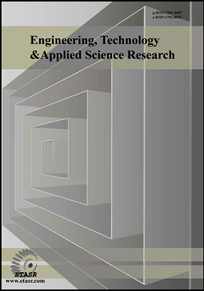Identifying the Impact of Concrete Specimens Size and Shape on Compressive Strength: A Case Study of Mud Concrete
Abstract
Mud is a versatile material with a prodigious interest for traditional wall construction such as wattle and daub or rammed earth, with and without reinforcements. Mud concrete has been identified as a unique modern material, though more research is required for generalization. Compressive strength, a measure of concrete quality usually depends on the specimen’s size and shape. Specimen’s size and shape for mud concrete is yet to be identified and established. Addressing this knowledge gap, this research aims at investigating the effect of specimen’s size and shape on the compressive strength of mud concrete. At first, the compressive strength’s variation was estimated by varying water content. Then, the water content was kept constant and the variations of compressive strength were estimated by varying specimen size and shape. Both experiments were conducted for different mixtures and percentages of cement. The initial results suggest that the compressive strength of mud concrete decreases with the increase of water content. The decrease indicated linear behavior with a constant gradient. Less influence on compressive strength was observed by considering specimen size, while the shape showed more contribution. The effect of specimen size and shape was increased with the increase of compressive strength.
Keywords:
mud concrete, compressive strength, specimen size and shapeDownloads
References
C. Udawattha, H. Galabada, R. Halwatura, “Mud concrete paving block for pedestrian pavements”, Case Studies in Construction Materials, Vol. 7, pp. 249–262, 2017 DOI: https://doi.org/10.1016/j.cscm.2017.08.005
F. R. Arooz, R. U. Halwatura, “Mud-concrete block (MCB): Mix design & durability characteristics”, Case Studies in Construction Materials, Vol. 8, pp. 39–50, 2018 DOI: https://doi.org/10.1016/j.cscm.2017.12.004
A. M. Neville, J. J. Brooks, Concrete Technology, Pearson Education Ltd, 1987
M. Gul, “Effect of cube size on the compressive strength of concrete”, International Journal of Engineering Development and Research, Vol. 4, No. 4, pp. 956-959, 2016
J. C. Morel, A. Pkla, P. Walker, “Compressive strength testing of compressed earth blocks”, Construction and Building Materials, Vol. 21, No. 2, pp. 303–309, 2007 DOI: https://doi.org/10.1016/j.conbuildmat.2005.08.021
O. Arioz, M. Tuncan, K. Ramyar, A. Tuncan, B. Karasu, K. Kilinc, W. Mortaja, “Specimen Size and Shape Effects on Measured Compressive Strength of Concrete”, International Ceramic, Glass Porcelain Enamel, Glaze and Pigment Congress, Eskisehir, Turkey, October 12-14, 2009
A. J. Hamad, “Size and shape effect of specimen on the compressive strength of HPLWFC reinforced with glass fibres”, Journal of King Saud University-Engineering Sciences, Vol. 26, No. 4, pp. 373–380, 2017 DOI: https://doi.org/10.1016/j.jksues.2015.09.003
E. A. Sahawneh, “Size effect and strength correction factors for normal weight concrete specimens under uniaxial compression stress”, Contemporary Engineering Sciences, Vol. 6, No. 1, pp. 57–68, 2013 DOI: https://doi.org/10.12988/ces.2013.13006
S. T. Yi, E. I. Yang, J. C. Choi, “Effect of specimen sizes, specimen shapes, and placement directions on compressive strength of concrete”, Nuclear Engineering and Design, Vol. 236, No. 2, pp. 115–127, 2006 DOI: https://doi.org/10.1016/j.nucengdes.2005.08.004
M. A. Mansur, M. M. Islam, “Interpretation of concrete strength for nonstandard specimens”, Journal of Materials in Civil Engineering, Vol. 14, No. 2, pp. 151–155, 2002 DOI: https://doi.org/10.1061/(ASCE)0899-1561(2002)14:2(151)
A. M. Neville, “A general relation for strengths of concrete specimens of different shapes and sizes”, Journal Proceedings, Vol. 63, No. 10, pp. 1095–1110, 1966 DOI: https://doi.org/10.14359/7664
J. K. Kim, S. T. Yi, C. K. Park, S. H. Eo, “Size effect on compressive strength of plain and spirally reinforced concrete cylinders”, ACI Structural Journal, Vol. 96, No. 1, pp. 88-94, 1999 DOI: https://doi.org/10.14359/599
E. Y. Zhu, W. Yang, J. H. Wang, W. Q. Lin, “Relationship of compressive strength of specimens with various shapes and sizes for C20 MPa grade concrete”, Journal of Northern Jiaotong University, Vol. 2005, No. 1, pp. 1-3, 2005 (in Chinese)
ASTM C 617, Standard Practice for Capping Cylindrical Concrete Specimens, ASTM International, 2003
M. Dehestani, I. M. Nikbin, S. Asadollahi, “Effects of specimen shape and size on the compressive strength of self-consolidating concrete (SCC)”, Construction and Building Materials, Vol. 66, pp. 685–691, 2014 DOI: https://doi.org/10.1016/j.conbuildmat.2014.06.008
J. K. Kim, S. T. Yi, “Application of size effect to compressive strength of concrete members”, Sadhana, Vol. 27, pp. 467–484, 2002 DOI: https://doi.org/10.1007/BF02706995
M. Li, H. Hao, Y. Shi, Y. Hao, “Specimen shape and size effects on the concrete compressive strength under static and dynamic tests”, Construction and Building Materials, Vol. 161, pp. 84–93, 2018 DOI: https://doi.org/10.1016/j.conbuildmat.2017.11.069
British Standard, EN 12390-3 (2009): Compressive Strength of Test Specimens, British Standards, 2009
J. K. Murdock, “Effect of length to diameter ratio of specimen on the apparent compressive strength of concrete”, ASTM Bulletin, Vol. 221, pp. 68–73, 1957
ASTM C 39/C39M-03, Standard Test Method for Compressive Strength of Cylindrical Concrete Specimens, ASTM International, 2012
British Standards Institution and G. Cement Aggregates and Quarry Products Standards Committee, Testing Concrete, British Standards Institution, 1983
Downloads
How to Cite
License
Copyright (c) 2019 Engineering, Technology & Applied Science Research

This work is licensed under a Creative Commons Attribution 4.0 International License.
Authors who publish with this journal agree to the following terms:
- Authors retain the copyright and grant the journal the right of first publication with the work simultaneously licensed under a Creative Commons Attribution License that allows others to share the work with an acknowledgement of the work's authorship and initial publication in this journal.
- Authors are able to enter into separate, additional contractual arrangements for the non-exclusive distribution of the journal's published version of the work (e.g., post it to an institutional repository or publish it in a book), with an acknowledgement of its initial publication in this journal.
- Authors are permitted and encouraged to post their work online (e.g., in institutional repositories or on their website) after its publication in ETASR with an acknowledgement of its initial publication in this journal.





